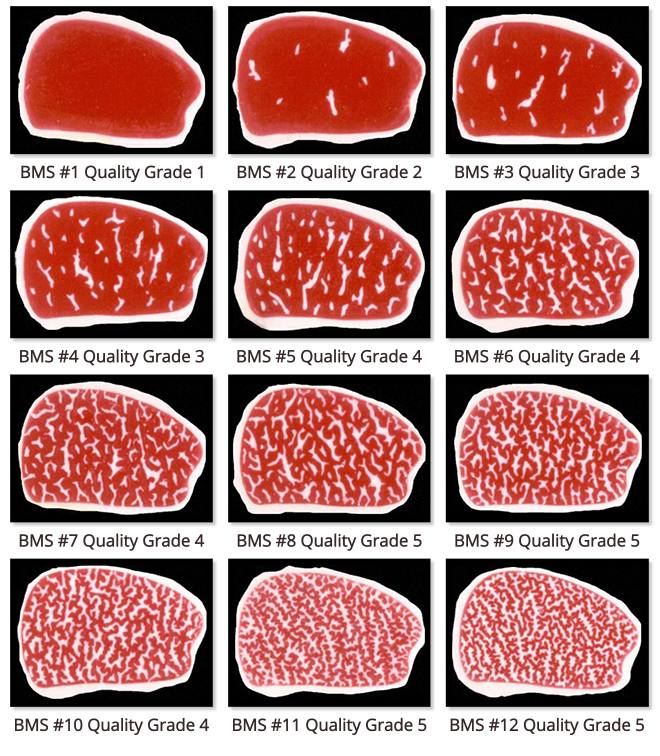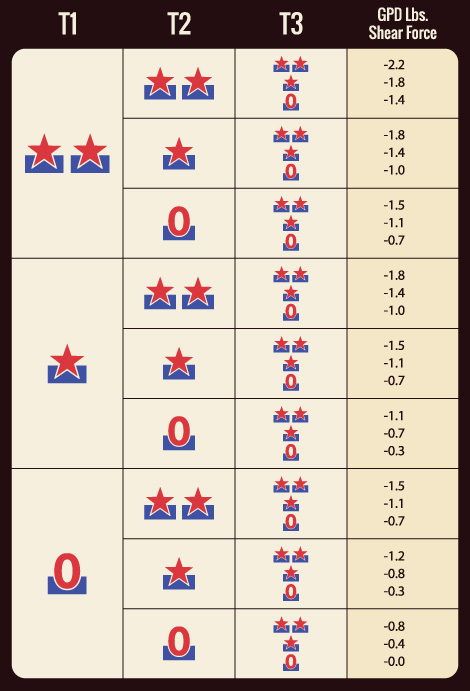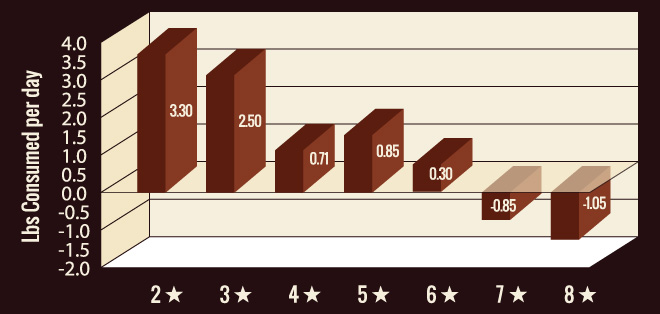What is WAGYU Beef?
The breed that made Kobe Beef famous.
WAGYU - a Japanese beef cattle breed
Derived from native Asian cattle, 'WAGYU' refers to all Japanese beef cattle, where 'Wa' means Japanese and 'gyu' means cow.
Wagyu--the breed that made Kobe Beef famous--is the generic name for Japanese cattle. Considered a national treasure by their native country, they produce the world’s best tasting beef and the most healthful, too, due to its uniquely high ratio of oleic acid. The substantial premiums being offered for Wagyu influenced feeder calves plus calving ease are just two reasons why this breed is in high demand for domestic and export markets.
What is WAGYU A5?
Beef cattle is classified into four categories: Japanese Black, Seed Japanese Brown, Japanese Shorthorn, and Japanese Polled. It is Japanese Black of which number of breeding is the largest among them.
The standards of grading beef consist of Yield Grade and Quality Grade. “A” of “A5″ means the yield grade, while “5” shows the quality grade.
Moreover, the Japanese beef grading system has 5 quality grades. They are (1) marbling, (2) meat color and brightness, (3) firmness and texture of meat, and (4) color, luster and quality of fat.
Beef Marbling Standard

WAGYU Cattle For SaleView Now
A national treasure by their native country.
WAGYU BREEDING
This is a somewhat complicated subject, especially due to the unfamiliarity of the breed to most Westerners, not to mention the use of Japanese in the naming traditions. But only by understanding the Wagyu bloodlines and the qualities that each bloodline carries with it can we capitalize on the outstanding meat quality possible through skillful breeding. Traditionally, the Japanese have used linebreeding to produce great bulls and cows much more than australian or american Wagyu breeders.
While linebreeding is different from inbreeding – an inbreeding coefficient of less than 25% is tolerable – westerners have shied away from linebreeding for fear of negative inbreeding results. There are three major bloodlines of Wagyu – Tajima, Fujiyoshi, and Kedaka – and each differs in size, marbling quality, and maternal abilities.
Takeda’s Rotational Breeding
The master breeder, Shogo Takeda, began breeding Wagyu over 50 years ago and has developed a diagram based on the genetic makeup of bulls. To simplify the approach, he would say that bulls are divided into 4 basic groups: A, B, C & D. Takeda’s method is to take a female created by an “a” bull and mate her to a “B” bull – and to take a female created by a “B” bull and mate her to a “C” bull, etc. See diagram:
GROUP A – (FUJIYOSHI - ITOZAKURA LINES): Large size, good marbling, excellent maternal sire. GROUP B – (HIGH TAJIMA): Small size, best marbling, poor maternal sire. GROUP C – (KEDAKA – ITOZAKURA LINE): Large size, good marbling, excellent maternal sire. GROUP D – (HIGH TAJIMA): Medium size, better marbling, average maternal sire.
Pair “D” Female
with “A” Male
GROUP A
- TF Itohana 2 (TF35)
- Kinto (TF39)
- Itomoritaka ETJ002
- TF Itomichi 1-2 (TF36)
- Kikuhana (TF37)
- LMR ToSHIRo 723T
Pair “A” Female
with “B” Male
GROUP D
- Sanjirou
- Haruki II
- Shigeshigetani
- Itoshigenami TF148
- LMR YoSHIRo 716T
- UseasF1Sire
GROUP B
- Itoshigenami TF148
- Kitateruyasudoi ETJ003
- Michifuku
- Yasufuku Jr.
- JVP Kikuyasu 400
- JVP Fukutsuru 068
- Kikutsurudoi TF146
- Shigeshigetani
- LMR YoJIMBo 6345
- Use as F1 Sire
Pair “C” Female
with “D” Male
GROUP C
- Itoshigefuji TF147
- Hirashigetayasu ETJ001
- Itozurudoi TF151
- TF Itomichi 1-2
- TF Kikuhana
- Kitaguni Jr.
- Takazakura
- LMR ToSHIRo 723T
Pair “B” Female
with “C” Male
Healthy WAGYU Cows
GeneSTAR® Tenderbess - This was the first multigene single trait DNA test commercially available to the beef industry. It combines test results for several markers and genes for the same trait. The test is based, in part, on two genes involved in the post-mortem tenderization process: Calpastatin and Calpain, Calpain is an enzyme which weakens muscle fibers thereby making the fibers more tender. Calpastatin is an enzyme which inhibits the post-mortem tenderization process by inhibiting the effects of Calpain.
GeneSTAR® Tenderness
Genetic Progeny Difference

Animals carrying the favorable forms of the genes have been found to significantly reduce the proportion of “tough” eating experiences. The impact of these two genes on tenderness has been well documented for quite some time. However, through the use of DNA tests first available from Bovigen, there is now an effective and efficient tool available to use this knowledge in making breeding and management decisions.
Tenderness is typically evaluated in research environments through the use of Warner-Bratzler shear forse (WBSF) tests. Collection and evaluation of the type of data is time consuming and expensive, which makes it difficult to evaluate this trait in breeding animals at a yong age or on a large scale. One of the key benefits of DNA technology is the ability to provide genetic information at a young age. This is especially true on traits relating to carcass merit.
GeneSTAR® Feed Efficiency - GeneSTAR® Feed Efficiency is based on Net Feed Intake (NFI). NFI is the difference between an animal’s actual feed intake and the amount of feed an animal is expected to eat based on its size, composition and growth rate.
Calves that eat less than expected will have a negative NFI
Negative NFI = Superior Feed Efficiency
Calves that eat more than expected will have a positive NFI
Positive NFI = Inferior Feed Efficiency
NFI has been proven to be a better trait than Feed Conversion for improving True Feed Efficiency. Feed Conversion is a ratio of lbs of consumption versus lbs of gain. It is possible to improve this ratio by improving gain with no impact on True Feed Efficiency. This generally results in heavier carcass weights and heavier mature size, both of which are often a negative in terms of reducing the cost of producing beef. Whether yours is a cow calf operation where feed costs typically make up more than 65% of the total variable costs or a feedyard where a 20% improvement in feed conversion can affect profitability by more that $60/hd; feed efficiency is a trait that directly affects the bottom line.
GeneSTAR® Feed Efficiency consists of four markers which together identify as much as a 15% difference in daily feed consumption with no affect on other traits like Average Daily Gain, Carcass Weight, Quality Grade or Yield Grade.
Daily Feed Intake by STARS
Lbs. Consumed per day

As can be seen in the graph above, selecting for animals with more stars for feed efficiency can dramatically reduce the lbs of feed consumed per day. This study showed a difference of as much as 4.15 lbs difference in feed consumed per day between 2 STAR and 8 STAR animals. With a ration cost of $225/ton and on feed for 150 days, the difference between a 2 STAR and an 8 STAR animal is $70.
Information Provided by GeneSTAR, Understanding DNA Technology
sign-up and stay informed
Thank You For Subscribing To
Wright Ranch and Cattle









